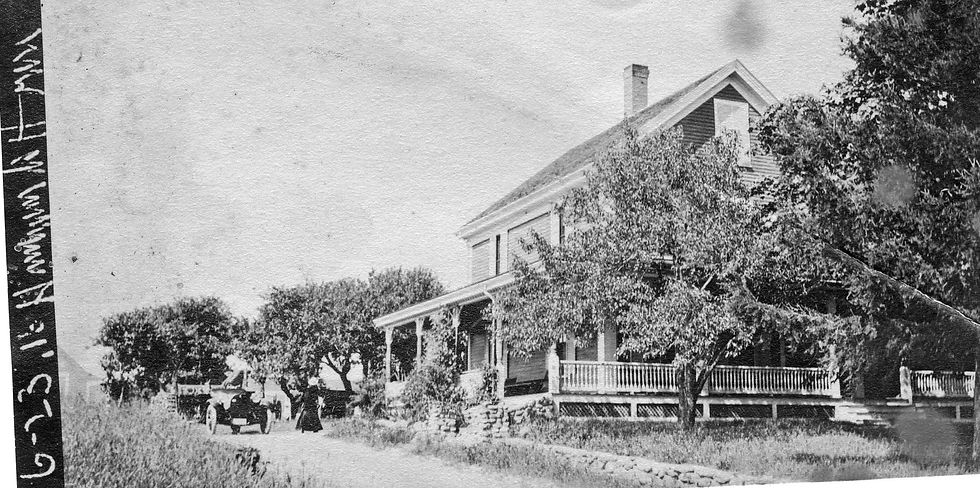Meet the Man Who Moved Scorton Harbor's Entrance
- Kaethe Maguire
- Dec 11, 2020
- 4 min read
Updated: Aug 10
Most people have no idea that the outlet for our Scorton Creek, once more appropriately called Scorton River, was moved to its current location in the early 1900s from the northern end of Hammond Road.
This happened under the tenacious efforts of one Robert A. Hammond who was a real wheeler-dealer on Cape Cod.

Although born in Provincetown, Mr. Hammond spent most of his adult life in East Sandwich at his home on the corner of Route 6A and Torrey Road; it still stands, however changed, as the office of the Riverview School.
He had extensive interests in the fishing industry and that was his primary reason for wanting to move Scorton Harbor. Drifting sands had built up to such a degree that they prevented ships from getting close to the shore and made access to fishing weirs very difficult.
Fishing weirs and fishing traps were big business in Sandwich.
In the spring of 1891, the selectmen were abuzz with requests for more permits for fishing weirs. They had to keep moving these traps farther west because of the shifting sands. A total of $8,600 was paid annually to Sandwich for leases of land on the Scorton River to set fish traps.
A major gale in December of 1885 greatly changed the location of sand dunes along the shore of the entire northern side of Sandwich. The footbridge and the marsh from Scorton Neck to Town Neck was entirely covered with water and stormwaters flooded much of what was called Jarvesville. On Scorton Neck marshes tons of hay were carried away and considerable damage was done to the Scorton Bridge, making it impossible to pass. The usual fishing areas had been greatly disturbed or ruined.
In the summer of 1889, J.R. Holway was hired to move Hammond’s fishing weirs from Dennis to the waters behind the Hammond house on Scorton Harbor, located at the end of what is now Hammond Road. Fishing weirs and fishing traps were big business in Sandwich.
In March of 1898 the legislative House Ways and Means Committee considered various bills asking for state appropriations for boat harbors along Cape Cod and the Vineyard. These bills were favorably reported by the Committee on Harbors. Scorton Harbor was granted $7,000.
By June of 1898, the bids were out from the State Board of Harbor Commissioners to cut a channel through a sand hill about 1,000 feet long and 28 feet deep at the highest point to create a new Scorton Harbor. For years the Scorton River ran by Scorton Neck in an almost straight line out to the waters of Cape Cod Bay. However, a sandbar formed at its mouth that in time became a sand hill and gradually worked eastward giving the river an “S” curve route and ruining the little channel that had traditionally run behind it.

The six images above are from a Hammond family album and show the harbor being dredged. The last photo, showing the completed entrance at low tide, was taken by Delia Nye, presumably in 1906-7. COURTESY JOHN NYE CULLITY
LEFT: a portion of a U.S. Coastal Survey from 1861 that shows the original entrance to Scorton Creek | COURTESY JOHN CULLITY. RIGHT: A modern rendering of the topography of 1667 | COURTESY SANDWICH TOWN ARCHIVES..
The above two Google map images show where the entrance to Scorton Creek is today, which is located just east of the end of North Shore Boulevard.
Besides his fisheries interests, Mr. Hammond also had freezing plants and wire rope manufacturing companies in Boston. He even had an orange-growing plantation in Florida.
In Sandwich, he bought the dilapidated site of the former Boston and Sandwich Glass works, last used in that capacity in 1868, and updated and reused some of the abandoned buildings.
He also built a new freezer plant and planned to build a lumber yard in that part of town.
Even as late as 1910 Mr. Hammond was to open a shoe factory on the site of the former Armstrong Braid Company. That same year he still had steam dredges in the back of the freezer buildings to enable ships to come closer to land fish, coal and lumber. I would expect this would be the area when Deming Jarves had his ship, the Acorn, pull up to load the glass wrapped in marsh hay during the days of the Boston and Sandwich Glass Works.
Robert Hammond married a young woman of Spring Hill, Nellie, the daughter of Mr. and Mrs. Seth Jones, on January 2, 1888, and spent most of his adult life in East Sandwich with his wife and their daughter, Mary, who would become a Doctor of Medicine, or “a lady doctor,” as folks would say.
Mr. Hammond died in 1915.




Kaethe Maguire is a member of the Friends of the Sandwich Town Archives, a dedicated, all-volunteer, 501(c)(3) nonprofit committed to supporting and promoting the archives’ collections and the rich, diverse history of the town of Sandwich.

























Comments